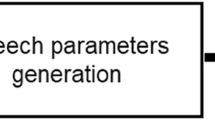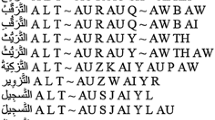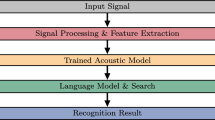Abstract
Distinctive phonetic features (DPFs) provide the description of phonemes’ places and manners of articulation. Several, sometimes contradictory, views and definitions of the DPF elements of Modern Standard Arabic have been proposed in the phonology literature. This contrast in views is a significant barrier against utilizing the advantages of DPFs in digital speech processing applications because computer systems do not deliver correct results under vague rules and models. This is a review paper that presents background on Arabic DPFs and in addition to highlighting the historical and geographical verities. It also addresses the problem of ambiguous definitions between classical and modern phonology that may introduce significant challenge to computer scientists and engineers when developing computer systems. Another contribution of this work is to investigate the deviations in phonemes and DPF elements across dialects of Arabic. This is important to provide engineers with better understanding when designing computer software targeting a wide spectrum of Arabic speaking users.


Similar content being viewed by others
Change history
04 October 2018
The affiliation of author Mansour Alghamdi reads: National Center for Assessment, Riyadh, Saudi Arabia. Email: m.ghamdi2@qiyas.org
References
AbdutTawaab, R. (1997). Almadkhalu Ela Elmil Lughati wa Manahijul Bahthil Lughawi. Cairo: Alkhanji Library.
Abu Shamah, A. I. I. (1992). Abrazul Maani Min Hirzil Amaani. Almadinah: Islamic University Publications.
AbuHassan, T. (1990). Manahijul Bahthi Fil Lughah. Cairo: Anglo Library.
Abulfath, U. I. J. (1993). Sirru Sinaa’atil Eeraab (2nd ed.). Damascus: Darulqalam.
Alanbari, A. A. (1999). Asraarul Arabiyah (1st ed.). Beirut: Darul Arqam.
Al-Ani, S. H. (1970). Arabic phonology (1st ed.). Hague: Mouton Publishers.
Alfarahidi, A. I. A. (2003). Alayn (1st ed.). Beirut: Darul kutubil Elmiyah.
Alghamdi, M. (2000). Arabic phonology (1st ed.). Riyadh: Tawbah Publisher.
Alghamdi, M. (2003) KACST Arabic phonetic database. In: The 15th International Congress of Phonetics Science, Barcelona, Spain (pp. 3109–3112). Barcelona: Universitat Autònoma de Barcelona.
Alghamdi, M. (2015). Arabic phonetics and phonology (1st ed.). Riyadh: Tawbah Publisher.
Alghamdi, M., Alhargan, F., Alkanhal, M., Alkhairy, A., Eldesouki, M., & Alenazi, A. (2008). Saudi accented Arabic voice bank. Journal of King Saud University, 20, 45–64.
Alkhafaaji, I. (1982). Sirrul Fasahah (1st ed.). Beirut: Darul kutubil Elmiyah.
Alkhouli, M. (1990). Linguistic phonetics (1st ed.). Swaileh: Daar Alfalah.
Alotaibi, Y., & Meftah, A. (2013). Review of distinctive phonetic features and the Arabic share in related modern research. Turkish Journal of Electrical Engineering and Computer Sciences, 2, 426–1439.
Anees, I. (2013). Alaswaatul Laghawiyah. Cairo: Anglo Library.
Ashatibi, A. M. A. (2014). Manzhumatu Hirzil Amaani wa Wajut Tahani Fil Qira’aatis Sab’a. Damascus: Daru Nouril Maktabaat.
Assa’aran, M. (1997). Elmul Lughah. Cairo: Darul Fikikr Alalrabi.
Assakhaawi, A. (2002). Fat’hulWasid Fi SharhilQasid. Riyadh: Arrushd.
Azzajjaji, A. I. I. (1984). Aljumalu Finnahu (1st ed.). Beirut: Arrisalah Est.
BBN Technologies (with American University of Beirut a subcontractor), et al. (2005). BBN/AUB DARPA Babylon Levantine Arabic Speech and Transcripts LDC2005S08 (1st ed.). Philadelphia: Linguistic Data Consortium.
Benmamoun, E., & Bassiouney, R. (2017). The Routledge handbook of Arabic linguistics (1st ed.). New York: Routledge.
Biadsy, F., Hirschberg, J., & Habash, N. (2009). Spoken Arabic dialect identification using phonotactic modeling. In The 2009 Workshop on Computational Approaches to Semitic Languages, Athens, Greece (pp. 53–61). Stroudsburg: ACL.
Bishr, K. (2000). Elmul Aswaat. Cairo: Darul Ghareeb.
Chomsky, N., & Halle, M. (1968). The sound pattern of English (1st ed.). Cambridge: MIT Press.
Deller, J., Proakis, J., & Hansen, J. H. (1993). Discrete-time processing of speech signal. New York: Macmillan.
Droua-Hamdani, G., Selouani, S. A., & Boudraa, M. (2010). Algerian Arabic speech database (ALGASD): Corpus design and automatic. The Arabian Journal for Science and Engineering, 35(2C), 157–166.
Eide, E. (2001). Distinctive features for use in an automatic speech recognition system. In 7th European Conference on Speech Communication and Technology, Aalborg, Denmark (pp. 1613–1616). Baixas: ISCA.
El-Imam, Y. A. (1989). An unrestricted vocabulary Arabic speech synthesis system. IEEE Transactions on Acoustics, Speech and Signal Processing, 37, 1829–1845.
Garofolo, J. S., et al. (1993). TIMIT acoustic-phonetic continuous speech corpus LDC93S1 (1st ed.). Philadelphia: Linguistic Data Consortium.
Huda, M. N., Muhammad, G., & Nitta, T. (2006). DPF-based phonetic segmentation using recurrent neural networks. In Autumn meeting of ASJ, 19–21, Yahata Higashi, Kitakyushu, Fukuoka, Japan (pp. 3–4). Tokyo: ASJ.
IbnulJazary, M. I. M. (1998). Annashr Fil Qiraatil Ashr (1st ed.). Beirut: Darul Kutubil Elmiyah.
IbnuSsarraaj, A. I. S. (1988). Al’Osoulu Finnahw (3rd ed.). Birout: Arrisalah Est.
International Phonetic Association. (1999). Handbook of the international phonetic association: A guide to the use of the international phonetic alphabet. Cambridge: Cambridge University Press.
Jakobson, R., Fant, G. M., & Halle, M. (1963). Preliminaries to speech analysis: The distinctive features and their correlates (1st ed.). Cambridge: MIT Press.
LaRocca, S., & Chouairi, R. (2002). West point Arabic speech LDC2002S02 (1st ed.). Philadelphia: Linguistic Data Consortium.
Maamouri, M., Buckwalter, T., & Cieri, C. (2004). Dialectal Arabic telephone speech corpus: Principles, tool design, and transcription conventions. In NEMLAR International Conference on Arabic Language Resources and Tools, Cairo, Egypt (pp. 1–6). Paris: ELRA.
Mukhtaar, A. (1997). Dirasatus Sawtil Lughawi. Cairo: Aalmul Kutub.
Sībawayh, A. I. U. (1988). Alkitaab (3rd ed.). Cairo: Alkhanji Library.
Acknowledgements
This project was funded by the National Plan for Science, Technology and Innovation (MAARIFAH), King Abdulaziz City for Science and Technology, Kingdom of Saudi Arabia, Award Number (11-INF1968-02).
Author information
Authors and Affiliations
Corresponding author
Additional information
The original version of this article was revised. The affiliation of author Mansour Alghamdi reads: National Center for Assessment, Riyadh, Saudi Arabia. Email: m.ghamdi2@qiyas.org.
Rights and permissions
About this article
Cite this article
Seddiq, Y., Alotaibi, Y., Meftah, A. et al. Revisiting distinctive phonetic features from applied computing perspective: unifying views and analyzing modern Arabic speech varieties. Int J Speech Technol 21, 907–913 (2018). https://doi.org/10.1007/s10772-018-9548-z
Received:
Accepted:
Published:
Issue Date:
DOI: https://doi.org/10.1007/s10772-018-9548-z




